The Wolsey Pageant(s)
Above: a dress
rehearsal of the Wolsey Pageant on the lawn in front of Christchurch
Mansion in 1930 (not 1923 as shown). The director Nugent Monck is the besuited chap in the homburg
at front-centre. The empty benches are ready for the audience to arrive.
David Saunders, writing in The
Ipswich Society Newsletter in April, 2023: 'I have several
postcards taken by Harry Walters, a local photographer. One or two of
these also show the man in the hat who must have been the
director/producer. There is no mention of a director in the programme
but the list of officials is headed by the producer, Mr Nugent
Monck. I assume the photographs were taken during a dress rehearsal so
that the postcards would be ready to sell at the performances. There
have been at least two other pageants in Christchurch Park; one in 1931
To Kill the Queen and another
in 1951.' (See the images below.)
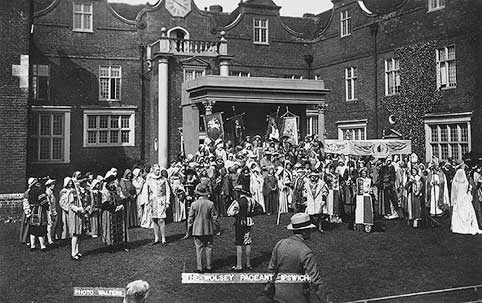 A different view of the Pageant
rehearsals, courtesy David Saunders
A different view of the Pageant
rehearsals, courtesy David Saunders
The Wolsey Pageant commemorated the 400th anniversary of the town’s
most famous son, Cardinal Thomas Wolsey. It seems to have been a great
success. 25,000 people saw one of the nine proper performances or two
dress rehearsals, and it was close to being an absolute sell-out. A
side grandstand for 400 people was seemingly put up at the last minute,
the organisers having anticipated extra demand for tickets. At its
close, there was a lot of applause, cheering and celebrating, with
speeches from the director, Nugent Monck, other organisers and the
Mayor – all lauding the civic commitment of both the public and the
performers.
In contrast to many other cities, Ipswich was still booming in 1930;
the first fifty years of the twentieth century were an intensification
of its late nineteenth-century economic and social growth, despite a
weaker national picture. By this decade it had lost much of its rural
identity. The town’s population continued to grow to 80,000 by 1921,
almost 90,000 by 1931, and to 105,000 by 1951. The organisation of the
pageant was supported by the town council which had presided over this
growth. Ipswich was designated as a County Borough in 1888, and its
council was ‘seriously’ involved in late nineteenth-century municipal
socialism. It invested strongly in the port, in public health
facilities (such as water supply and sewerage), in gas and electricity,
and in education and culture – not to mention the construction of a set
of worthy civic buildings, including the Town Hall, the Corn Exchange,
libraries and museums. By the inter-war period there were also
important public sector investments in entertainment and service
facilities – of which the Wolsey Pageant could be viewed as one example.
The pageant’s storyline was simple but intense with dialogue.
Fortunately, microphones and loud-speakers were installed so that the
words were clearly heard in the stands, though the press commented that
‘the voices often seemed to be separated from the speakers.’ The
pageant began with Wolsey, as a boy in Ipswich, watching a nativity
play of sorts: the story of Herod and his fear of a powerful figure of
religion perhaps acting as an allegory for Henry VIII and Wolsey
himself. The rest of the pageant was mostly based on Shakespeare’s Henry VIII, which depicted a
scheming and wily Wolsey plotting against Katherine of Aragon and also
secretly opposing Henry’s marriage to Anne Boleyn. Eventually he met
his come-uppance, lamented by many but not by the gleeful Dukes of
Norfolk and Suffolk. At points Monck did leave the Shakespearean play,
for instance, to show a representative of Wolsey founding a religious
school in Ipswich. Along with the prologue, these aspects of the
pageant were meant to demonstrate the great Cardinal’s love for
Ipswich, despite the fact that he barely returned.
The town took to the pageant and showed their local patriotism in other
ways. Local people cooperated with the council in gaily bedecking the
streets, and enthusiasm came also in the great rush of performer
volunteers. One hundred Suffolk girls, for example, applied for parts
as Henry VIII’s wives. Undoubtedly, the highlight of the celebrations
was the visit of the Prince of Wales (the future Edward VIII). He
arrived in his private plane at the Ipswich aerodrome and saw the first
twenty minutes of the pageant. At a special civic luncheon he gave a
brief speech and acknowledged that Ipswich was ‘very proud to claim
connection with this great English Cardinal and statesman.’ Such was
the demand, the cast was duplicated, with some characters being played
by two different actors; lots were drawn to decide which would play
when the Prince of Wales visited. Not just individuals but associations
also joined in the celebration; the pageant souvenir programme, at
points, read like a civic directory of local societies, educational
institutions, manufacturing firms and cultural institutions.
The Ipswich Evening Star
highly lauded the pageant, describing it as a ‘beautifully executed
dramatic spectacle’; a ‘glowing feast’ of colour’; and a ‘spectacle
never to be forgotten, magnificent in conception, triumphantly
beautiful in execution, and profoundly inspiring in effect.’ [Information from
https://historicalpageants.ac.uk/pageants/1243]
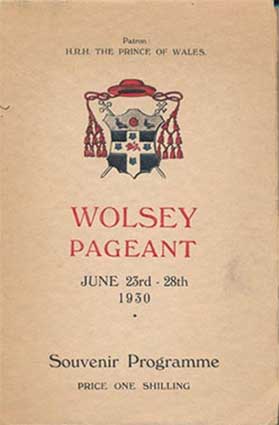 The cover of the programme, courtesy David
Saunders
The cover of the programme, courtesy David
Saunders
Money raised by the pageant went towards the building of The Wolsey Art
Gallery as an adjunct to Christchurch
Mansion.
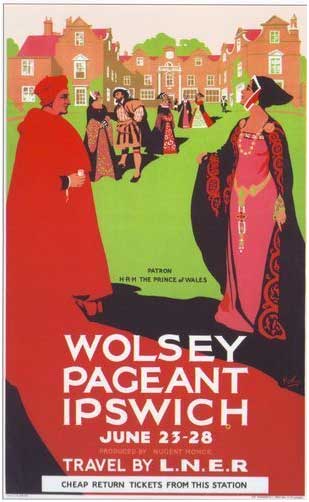 A London & North East Region railway poster promoting
the 1930 Pageant
A London & North East Region railway poster promoting
the 1930 Pageant
Later pageants
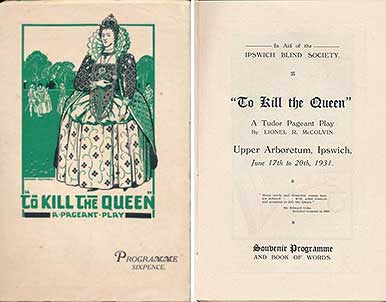 The 1931 Pageant programme, courtesy
David Saunders
The 1931 Pageant programme, courtesy
David Saunders
'TO KILL THE QUEEN: A pageant Play;
In aid of the Ipswich Blind Society; "To Kill The Queen: A Tudor
Pageant Play by Lionel R. McColvin; Upper Arboretum, Ipswich; June 17th
yp 2oth, 1931; [a dramatic quotation in small text is followed by]
Souvenir Programme and book of words'.
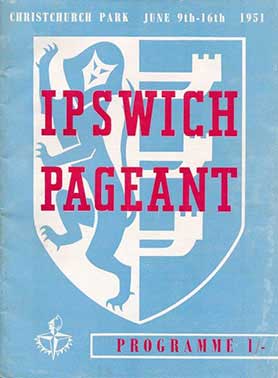 The 1951 Ipswich Pageant programme, courtesy
David Saunders
The 1951 Ipswich Pageant programme, courtesy
David Saunders
The cover reads: 'Christchurch Park, June 9th-16th 1951; IPSWICH
PAGEANT; Programme 1/-'.
It is notable that the designer has placed a stylized dramatic mask on
the head of the lion rampant on the Ipswich crest. The comedy/tragedy
masks appear in the compass points motif below.
Related pages
Wolsey's College
Wolsey 450
Wolsey550
Home
Please email any comments
and contributions by clicking here.
Search Ipswich
Historic Lettering
©2004
Copyright
throughout the Ipswich
Historic Lettering site: Borin Van Loon
No reproduction of text or images without express written permission
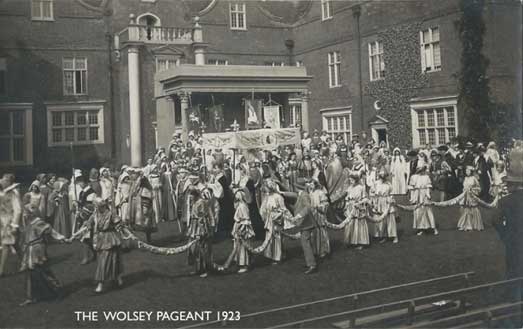

 A different view of the Pageant
rehearsals, courtesy David Saunders
A different view of the Pageant
rehearsals, courtesy David Saunders The cover of the programme, courtesy David
Saunders
The cover of the programme, courtesy David
Saunders A London & North East Region railway poster promoting
the 1930 Pageant
A London & North East Region railway poster promoting
the 1930 Pageant The 1931 Pageant programme, courtesy
David Saunders
The 1931 Pageant programme, courtesy
David Saunders The 1951 Ipswich Pageant programme, courtesy
David Saunders
The 1951 Ipswich Pageant programme, courtesy
David Saunders